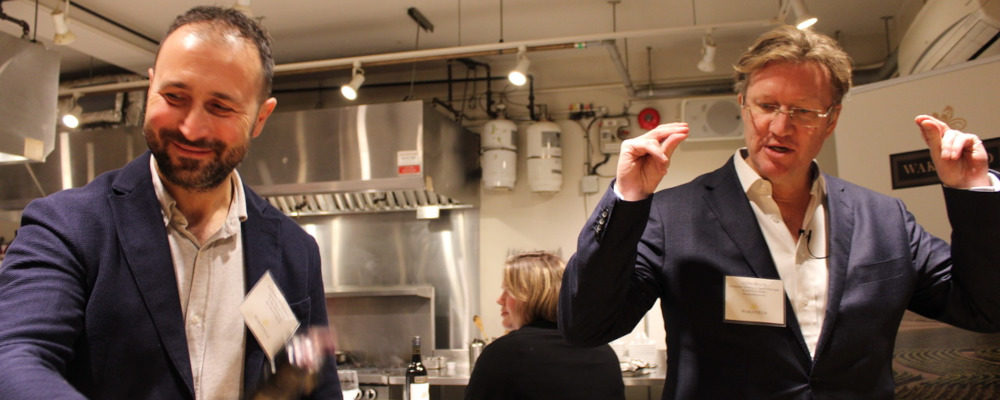Before we met up in a Toronto hotel coffee shop last week, just a little more than two years had passed since I had looked upon Justin Taylor’s unmediated, smiling face. The last time we had been in the same room was the morning of March 7, 2020, and Taylor was due to head back to Australia that evening after a Canadian tour promoting his family’s line of Wakefield Wines. Taylor is one of my favourite sources of information on what’s happening in Australian wine because he is as open as he is gregarious, and we had been in touch over the pandemic, arranging Zoom interviews over the International Time Zone. But to see him in the flesh was an overdue pleasure and, I hoped, a sign that the world wine trade was finally on its way to a new normal.
Wakefield’s main estate and centre of production is in the Clare Valley in South Australia. It was founded by Justin’s father Bill Taylor (Sr.) in 1969. It’s still very much a family business, and in Australia, it’s known as Taylors, but a certain Portuguese Port concern had trademarked the name elsewhere, and in Canada and much of the world they use the name of the original vineyard. All of this is to say that Justin Taylor, who is in charge of the family’s exports and was born the year the winery was established, brings with him more than a half-century of institutional memory of the modern Australian wine industry.
Taylor explained that the past two years had been more than eventful for the family business, and not just because he was grounded. Not only did Wakefield and their colleagues work through the lockdowns and supply chain interruptions of the initial pandemic, but in March of 2021, the People’s Republic of China imposed tariffs of between 100 and 200 percent on Australian wine.1“But in March last year, China decided to impose damaging anti-dumping tariffs on Australian wine of between 116.2 per cent and 218.4 per cent. The tariffs applied to wine sold in containers of 2 litres or less and will remain in place for five years.” https://www.abc.net.au/news/2022-03-18/wto-dispute-on-australian-wine-exports-into-china/100916852 (This followed from Australian criticism of the Chinese government’s human rights record and its call for an independent investigation into the origins of COVID-19.)2“Australia more openly criticized China’s encroachments on the South China Sea—vital for Australian shipping—where Beijing built military installations on man-made islands to solidify its contested claim to nearly the entire waterway. Turnbull also grew alarmed by the sums of Chinese money sloshing around Australian politics, spent to sway government policy in China’s favor. That led to new legislation designed to curtail foreign influence. Then in 2018, Turnbull’s government banned Chinese telecom giant Huawei from supplying equipment for Australia’s 5G networks, considering it too much of a security risk to essential infrastructure. Relations really fell off a cliff in April 2020, when current Prime Minister Scott Morrison’s government called for an independent investigation into the origins of the coronavirus outbreak—a prickly issue in Beijing, where such demands are perceived as politically motivated efforts to tarnish China.” https://www.theatlantic.com/international/archive/2021/07/china-australia-america/619544/Taylor said he had six containers of wine en route to China when the measures were announced. Two made it but four were shipped back. They’re not selling wine in the PRC for the foreseeable future, but they managed to keep their staff there to sell to the rest of Asia.
According to Jens Barynin, chief economist at VIVI, a Toronto firm that tracks the global wine trade,3Full disclosure: I have consulted for VIVI Economics in the past, and Barynin is a friend. Australian wine exports were in decline, by volume and dollar amount, starting in 2016, even before the pandemic and Chinese tariffs. Since over 60 percent of Australian wine sales are exported Barynin described, in an email, the Australian wine trade as a “survival of the fittest situation”. So why was Justin Taylor smiling?
Taylor explained that Wakefield’s biggest market is domestic, and its biggest export market is New Zealand, which by antipodean standards is pretty close. He also explained that in export markets where Wakefield is a “mature brand”, like Canada, they have done very well. He joked that at the start of the pandemic, “It was toilet paper, pasta, and wine, and our sales went through the roof.”
While consumers are no longer hoarding cases of wine, and consumer sales of alcohol are returning to pre-pandemic levels, COVID accelerated the “premiumization” of the wine market whereby wine enthusiasts are drinking less, but better, so that Wakefield’s mid-range to high-range wines account for increasing sales.
That is not to say the negative effects of the pandemic are not completely behind Wakefield or the Australian wine. Supply chain interruptions are still a major headache.4“The coronavirus pandemic and its ripple effects have snarled supply chains around the world, contributing to shipping backlogs, product shortages and the fastest inflation in decades. But in a report released Thursday, White House economists argue that while the pandemic exposed vulnerabilities in the supply chain, it didn’t create them — and they warned that the problems won’t go away when the pandemic ends. ‘Though modern supply chains have driven down consumer prices for many goods, they can also easily break,’ the Council of Economic Advisers wrote. Climate change, and the increasing frequency of natural disasters that comes with it, will make future disruptions inevitable, the group said.” https://www.nytimes.com/2022/04/14/business/economy/biden-supply-chain.html Transport times have doubled: “It used to take us 12 weeks to get a container of wine to the U.S. or Canada; that’s now 16 to 20 weeks.”
In the end, Taylor expects these problems to eventually work out and is optimistic about the future of Australian wine and Wakefield’s place in it. “I see an opportunity for established, trusted brands in the post-pandemic world; Australian wine is always improving, and we’re getting better with age.”
That evening Justin Taylor put his family’s wines where his mouth was at a tasting dinner he hosted and I attended with about two dozen other Toronto-based wine journalists and “influencers”. Here’s what we tasted. Prices are for Ontario.
Wakefield Estate Chardonnay 2020 ($16.95)
Fruit from Padthaway and Clare Valley. Lean but fancy, in a Burgundian style (more Meursault than Chablis). Some oak barrel effect, but a mid-palate weight from four months on its lees. Stone fruit to citrus. This wine could easily hold its own as a party wine with hors d’oeuvres, or accompany a weekend lunch of roast chicken or salmon. Exceptional quality-to-price ratio.
Wakefield Estate Shiraz 2019 ($19.95)
Fruit from the Limestone Coast and Clare Valley. Inky, blue, and purple (plums) fruited and iodine on the finish. Resonate fruit, seasoned with a light hand of American oak and some herbal notes. Punches up on the quality to price ratio. Wants a grilled steak (or mushroom dish).
Wakefield Jaraman Cabernet Sauvignon 2018 ($24.95)
Fruit from the Clare Valley and Coonawarra. Jaraman means seahorse in Aboriginal and alludes to fossil formations found on the Clare Valley vineyard when it was planted. This is a kind of Platonic ideal of an Aussie Cabernet Sauvignon: intensely pure black cassis fruit held up in a gum tree veil of minty eucalyptus notes. Good acid and tannic structure. Demands a leg or rack of lamb.




